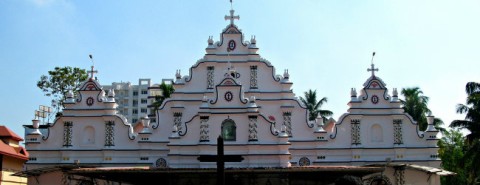India’s original Christians

If Westerners are no longer astonished to meet fellow Christians from distant corners of the world, many still assume that these believers must be newcomers to the faith. In some cases, though, African and Asian Christians can trace a thriving church history back to a time when only the boldest missionaries were venturing into the remote lands of northern Europe. Their ancestors were Christian long before my own Celtic forebears (and we in turn have a couple more centuries of Christian history than the English).
Most striking are the South Indian communities who report that they were converted by the apostle Thomas. Although Thomas himself may remain a shadowy figure, it’s very probable that Middle Eastern Christians did follow Roman trade routes and make their way to the Malabar Coast during the first century, and certainly by the second. Today you can meet Indians whose genealogies claim to record the actual moment of the family’s conversion in those ancient times.
Read our latest issue or browse back issues.
For over a thousand years, those communities flourished within Indian society, drawing extensively on the surrounding Hindu culture. They enjoyed a high caste status and followed caste rules and restraints. But they were also part of the global church. India looked to the Baghdad-based Church of the East, with its strongly Syriac and Semitic tone. This was the church of the Nasrani, the Nazarenes, which is still the name used for Thomas Christians. Their liturgy was and remains the Qurbana, recalling the Hebrew word korban, “sacrifice.”
Not until the 16th century did Thomas’s followers face a real identity crisis with the arrival of European Catholic clergy. These newcomers were delighted to find Christians in such a remote land, but baffled to meet believers who had never even heard of the pope and who thought the Christian church was headed by a patriarch in Babylon. And what were good Catholics to make of all their strange customs, which borrowed so heavily from pagan Hindus? Were these curious Indians really Christians at all?
Long efforts to integrate these old believers into a Western reality culminated in the Synod of Diamper in 1599, a heavy-handed attempt to suppress native Christian ways. Under Portuguese authority, the Catholic hierarchy tried to break the many links that bound the Thomas Christians to the Hindu environment and to their Syriac and Nestorian past. A mass burning of books and manuscripts followed. Diamper represents one of the grimmest moments in the often troubled encounter between Western and non-Western churches.
Yet India’s Christians survived these traumas. Over the centuries, complex schisms have divided the community into multiple churches—Roman Catholic, Orthodox, independent. Of 7 million believers today who trace their roots to Thomas, two-thirds belong to a Catholic branch (the Syro-Malabar and Syro-Malankara) and another 20 percent to Oriental Orthodox churches. Denominational niceties apart, different groups retain a strong sense of communal identity that is “Hindu in culture, Christian in faith and Syrian in liturgy.” Although they are only a minority of India’s 40 million or so Christians, their ancient traditions give Thomas’s heirs a special cachet among the churches.
This heritage survives in material form across the provinces of Kerala and Tamil Nadu. Tourists and pilgrims visit churches supposedly founded by Thomas himself at Cranganore (Kodungallur), Palayur and Niranam, and you can see the original site of his burial in Chennai (Madras). You could spend your life wandering between ancient Christian churches and shrines that claim first- or second-century origins and offer healing to all comers, regardless of faith or caste. This faith centered on shrines, pilgrimages and festivals is thoroughly Indian and absolutely familiar to Hindus.
But this Christian society is anything but a medieval survival. In recent decades, those areas of southern India in which native Christians are most in evidence have also taken the lead in economic growth, particularly in high-tech fields. Kerala, which is 20 percent Christian, is India’s most literate state, with Tamil Nadu not far behind. Christians make up 8 percent of the booming commercial metropolis of Chennai. Christianity blends as well with India’s emerging modernity as it once did with its old regime.
Like other Indians, Thomas Christians have migrated widely across North America, Europe and the Middle East. If you ever meet an Indian—usually with a darker complexion—whose surname sounds powerfully biblical or apostolic (such as John, Andrew, Abraham, Joseph or, of course, Thomas), then you may well be dealing with a Thomas Christian. Whatever else you say to them, please don’t ask them when they were converted and by what missionaries. If you do, you might hear an answer vastly longer than what you were expecting.






